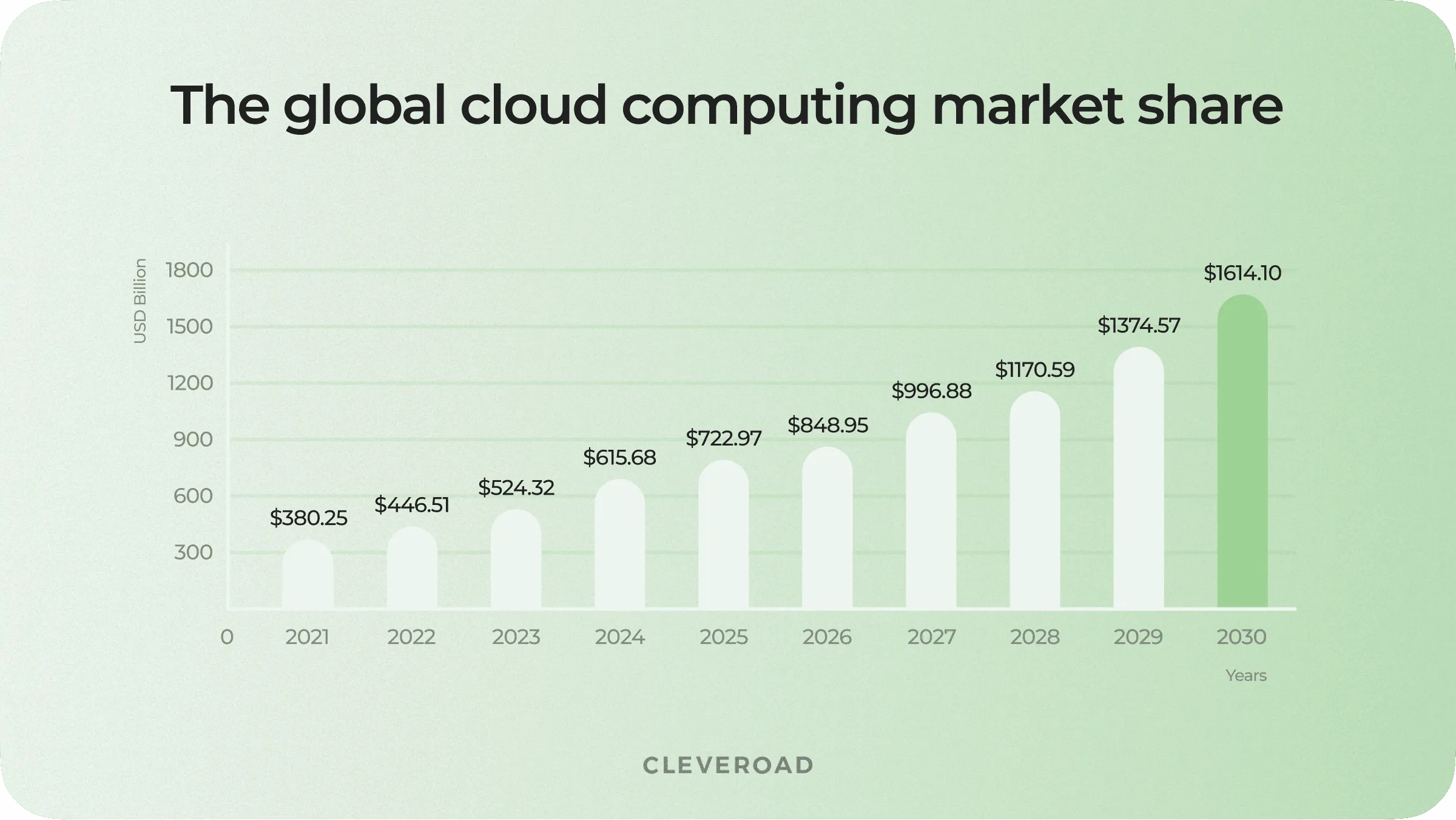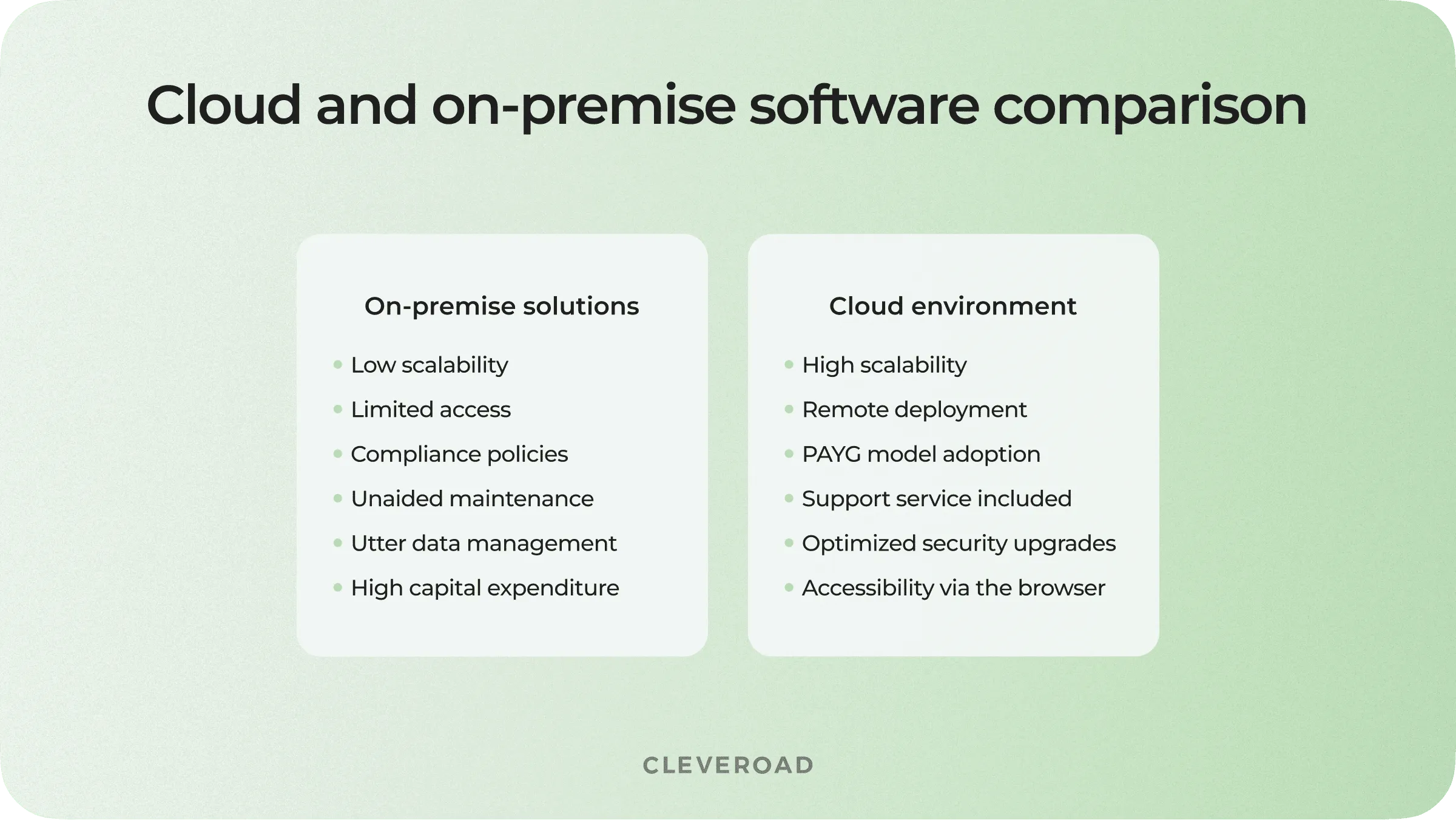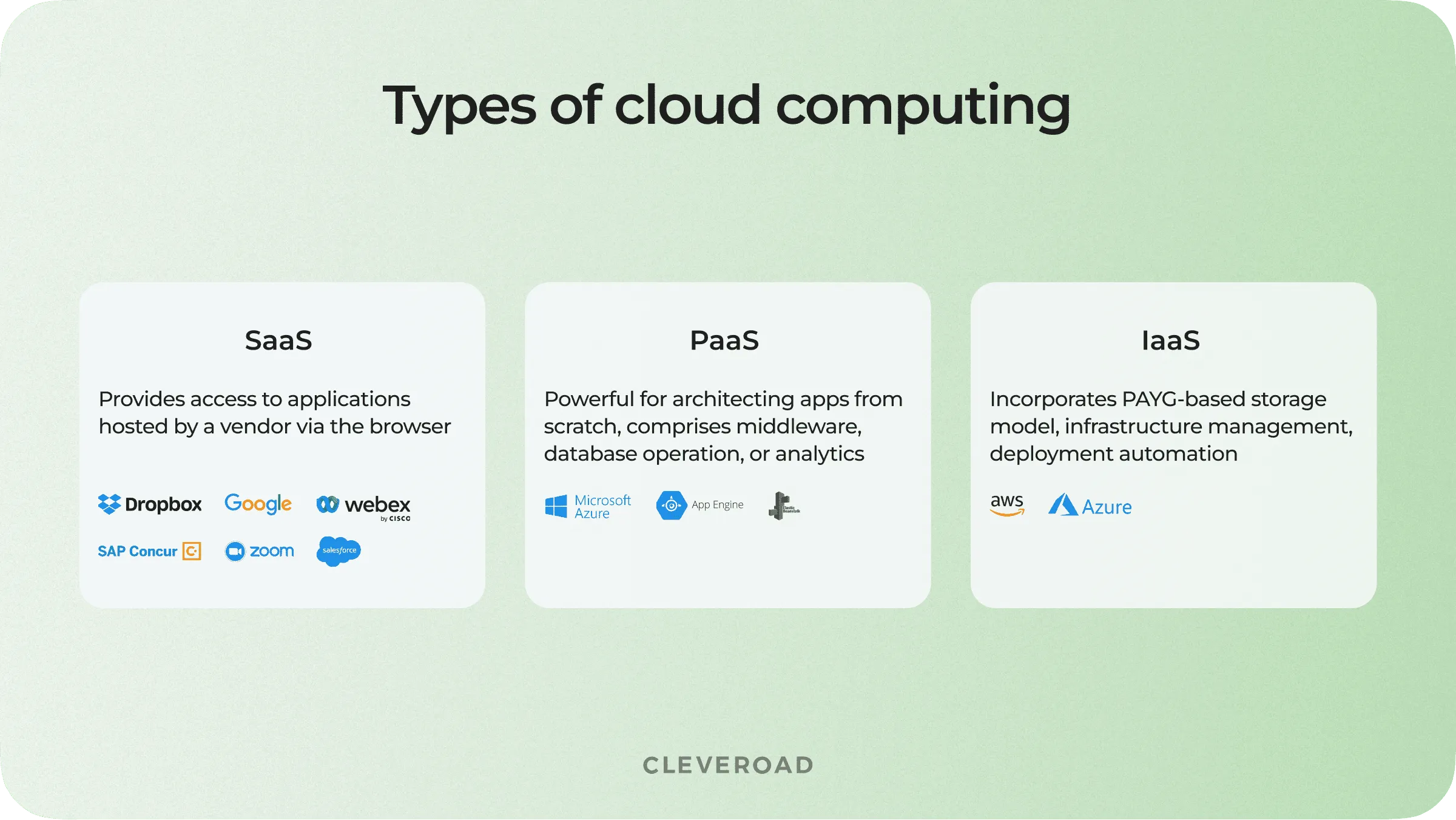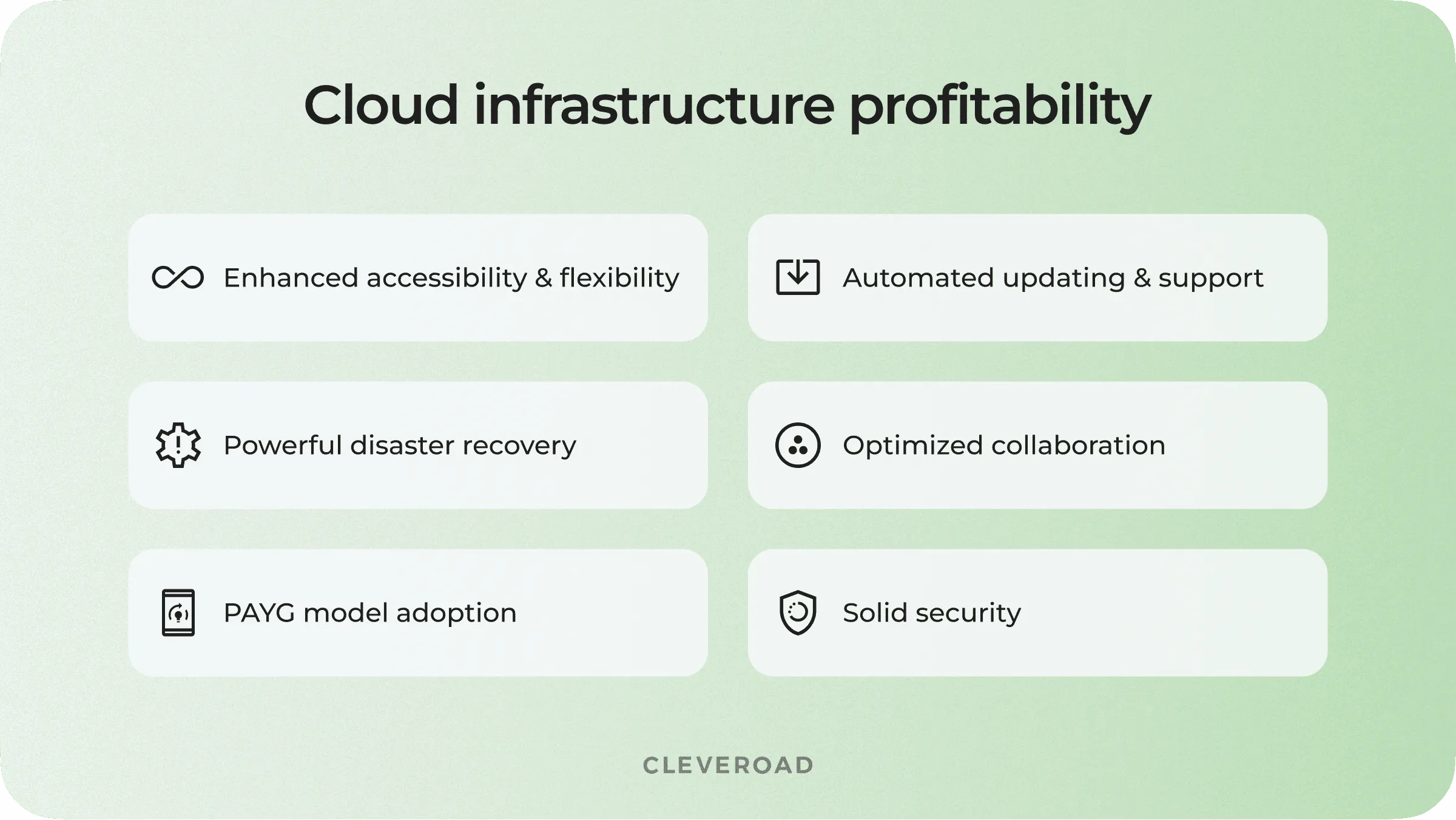Cloud Computing vs. On-Premise Solutions: What to Choose for Business?
Updated 07 Jul 2023
19 Min
1453 Views
Cloud infrastructure is not considered to be a novelty for today’s market- it is adopted by a great diversity of immense global entities from various industries. In spite of this point, we still may observe a proportion of businesses that remain performing their workflow via local servers and on-premise systems. This fact is conditioned by the choice complexity between the cloud and on-premise software architecture models.
The decision-making process concerning the two options is challenging, yet, determining for the profitability as well as the rentability of the company’s product in general. Let’s conduct an in-depth consideration of the difference between on-premise and cloud infrastructures, discuss existing models, tips, and benefits, as well as assess implementation risks to reveal which model is more relevant nowadays.
Existing Models of Deploying a Business Software System
What is the difference between on-premise and cloud models, and what architecture types basically exist? This is the primary question to unfold in terms of the suitable option choice. Currently, the tech industry represents the three major infrastructure forms:
Cloud Infrastructure
Cloud environments, also known as public cloud solutions, deliver scalable and flexible computing reserves accompanied by a sought-after pay-as-you-go model. Those aspects determine the key benefits of cloud over on-premise: public infrastructure ensures substantial investment decrease in the establishment’s digital workflow. The cloud-based environment is completely operated by third-party vendors, facilitating technical departments with ridding of the necessity to purchase, set, control, and maintain solutions on site.
In addition, public cloud products’ resources are highly elastic, providing maximal scalability and flexibility to handle the increased workload, guaranteeing operation solidity possible with strong exorbitance. Compatibility is one of the potent sides of cloud architecture: it is able to access such state-of-the-art solutions as Artificial Intelligence, Machine Learning, containers, Blockchain, serverless computing, cloud-native applications, etc.
Marc Benioff
Founder, CEO, and Chairman, Salesforce
If someone asks me what cloud computing is, I try not to get bogged down with definitions. I tell them that, simply put, cloud computing is a better way to run your business.
Within the frameworks of the technical side, the cloud environment implies the backend solution components defined within the predominant part of entity data centers- servers, steadfast storage, and networking facilities, yet with an enhanced scalability level. Some vast cloud vendors, incorporating hyper-scale cloud corporations (e.g., Facebook and LinkedIn), establish collaboration with providers to architect from-scratch infrastructure elements tailored to particular demands, such as power efficiency or operations that comprise Big Data and Artificial Intelligence.
On-premise
On-premise software, or the so-called private cloud, is an environment that is accessible for a single client processes performance. Instead of distributing a merger of resources with a row of customers, enterprises possess utter control over all of the resources delivered by a private cloud.
Private environments may be kept within the company’s data center or placed off-site and guided by a third party. The main point why on-premise is better than cloud is that the first option ensures more solid security, making compliance with stringent regulations easier and more straightforward.
The software operated via the local server streamlines data administration as well as storage challenges and ensures upper SLA (a service-level agreement, which is an obligation between a service vendor and a customer) execution and productivity.
Prevalently, license options for on-premise software fall under one of the categories mentioned below:
- Perpetual: traditionally used for a particular product version formed on a single-time purchase with unlimited permanent utilization
- Floating: defined number of licenses that can be used by any party which requires them
- Subscription: regular charging type that performs robotized renewal when the paid period is finished
Hybrid infrastructure
Apart from defining what is on-premise and cloud, it's significant to also be aware of this type: the hybrid cloud is a software computing environment that is based on cloud and on-premise solutions with the governance of numerous automated tasks to set a dynamic workflow within these platforms. This commonly engages an interrelation from the local data center to a cloud infrastructure. The connection may cover other private assets, such as edge gadgets or other clouds as well.
With the help of a hybrid infrastructure model, entities deploy their digital products through the cloud or on-premise environments and shift between them according to the necessary resources, defining the price. Such an opportunity provides enterprises with enhanced adaptiveness and expanded data deployment variants. A hybrid cloud workload comprises the network, hosting, and web service functionality of an application.
Building a hybrid solution requires three integral components:
- Cloud infrastructure as a service platform (e.g., Amazon Web Services, Microsoft Azure, or Google Cloud Platform)
- Local computing resources, to illustrate, on-premises data center
- Sufficient network connection to the hybrid cloud's local and cloud infrastructures
Booming cloud infrastructure adoption insights
To summarize the analysis of cloud computing vs on-premise infrastructures, let's examine an impressive report concerning the remote server location demand globally to prove the first model’s market prevalence:
- The cloud infrastructure service market value is projected to be equal to $623.3 billion by 2023 globally
- 94% of entities have already integrated a cloud environment in their workflows
- 30% of complete IT financial resources are invested in cloud technology
- 66% of businesses already possess a central cloud team or a cloud center of excellence.
- Companies leverage up to 5 diverse cloud frameworks standardly
- 50% of businesses allocate over $1.2 million for cloud services yearly
- By 2025, the data kept in cloud data centers will surmount 100 Zettabytes
As we may conclude, remote server location is highly demanded and rapidly progressing due to the vast amount of valuable benefits of the cloud vs on-premise model. Prosperous forecasts prove that such products are promising, potent, and efficient in terms of convenience, accessibility, and client catering.

Cloud technology market value worldwide
The Difference Between On-Premise and Cloud Solutions
As it was described previously, there is a range of major aspects that determine what is the difference between on-premise and cloud. The relevant environment specifically for your case should be chosen primarily by taking into account the demands, workflow peculiarities, and goals of your business.
In a nutshell, the key difference of cloud and on-premise is the location of the digital product, the place of installment, and operation. When it comes to the physical (local) device or server, we are talking about on-premise. In case it is set and operated via a remote server available via the Internet, it is considered to be cloud-based.
Deployment
On-premise: By comparing cloud vs onprem models, the driving difference is that applying the second infrastructure, the product is deployed in-house (engaging the organization’s digital environment). The company performs support and maintenance as well as all the arising associated processes.
Cloud: In contrast with cloud-based vs on-premise forms, within a public computing infrastructure, digital assets are hosted via the environment of the service vendor. Yet, businesses have access to those resources to apply them and scale up or down the cloud capacity according to ever-changing business requirements.
Cost
On-premise: On-premise infrastructure vs cloud are substantially higher with the first model- entities take over all of the arising expenses essential for the server hardware, power consumption, and storage.
Cloud: A great aspect of why is cloud better than on-premise for many enterprises is that they are charged due to the PAYG model, meaning investing only in engaged computing resources, excluding support and upkeep expenses. This fact makes the amount highly variable and determined by the used potential, yet the costs are still economized in contrast with the in-house option, adding more advantages of cloud vs on-premise.
Security
On-premise: Talking about more benefits of on-premise vs cloud, it is significant to mention that sectors where additionally sensitive data is retained and processed (such as Telemedicine or FinTech ) are required to obligatory have a particular level of security and confidentiality offered by in-house server placement.
Cloud: Within the cloud vs on-premise comparison, data protection issues are still considered to be the major drawback of the cloud computing environment. Due to third-party dependence, it is challenging to track whether the security level is sufficiently robust, resulting in privacy losses.
What is the crucial value of the cloud for the healthcare industry? Our article discloses the answer
Control
On-premise: Another on-premise and cloud difference is that with the in-house model, companies have utter data governance, processing, and usage. Due to this fact, enterprises in greatly regulated domains with additional security standards tend to hesitate regarding cloud environment deployment.
Cloud: Within the cloud hosting vs on-premise environments, the topic of data ownership is challenging and complex not only for customers but for providers as well. Data and encryption keys are retained by your standalone service vendor. Thus, in case of an abrupt outage, the data will be unavailable for a certain time period.
Compliance
On-premise: A range of today’s entities perform within some variant of regulatory governance, which impacts cloud server vs on-premise choice. Probably the most widely-faced one is the Health Insurance Portability and Accountability Act (HIPAA) for confidential medical data, yet there is a great diversity of others, such as the Family Educational Rights and Privacy Act (FERPA), comprising in-depth information of student records, and other government and field-specific guidelines.
For businesses operating under such regulations, it is fundamental to stay compliant when making the decision of cloud infrastructure vs on-premise, as well as monitor data processing and storage.
Cloud: Comparing cloud to on-premise, we may face a high responsibility level for the hosting services provider choice. Businesses should execute their due diligence to guarantee the full vendor’s compliance with essential regulatory mandates and acts identified by the industry. Private data must be protected, and clients, partners, stakeholders, as well as teammates, should have the guarantee of information confidentiality.

The key difference between cloud and on-premise models
Aside from covering cloud versus on-premise infrastructures’ peculiarities, you should be familiar with the three models that mirror the levels of resources available and delivered.
Software as a Service (SaaS) The first option is called Software as a Service (SaaS), and excludes straightforward client engagement in the utilization of cloud environment capacity in contrast to the following two types. Within this form, a vendor handles and operates an application, commonly installed as a multi-tenant model. Clients are authorized to run the service via a browser, which differs cloud services vs on-premise models. The generated client data from the application may be kept locally, in the cloud, or both.
Get acquainted with more details on how to build a SaaS platform
Infrastructure as a service (IaaS)
With this model, companies consume cloud environment elements such as capacity and services through solid online access. Commonly, this eventuates regular periodic expenses to the user and allows vendors to obtain income within rental or any existing PAYG model.
Apart from such basic cloud environment services, vendors deliver a vast range of more directed, specialized services. In practice, it may refer to container infrastructure, service fabrics, serverless functions, and managed network services - virtual private clouds, load balancers, domain name services, application delivery controllers, firewalls, and many others.
When deciding between a cloud-based system vs on-premise software, please note that third-party service providers traditionally set costs by assessed resources, with rates reflecting the consumption at a provided stage of efficiency.
Practical illustrations may be described as mentioned below:
- Growth of a standard virtual CPU size and appropriate storage;
- Storage service model (object or block), operation level (SSD or HDD), and accessibility
- Power assessed within utilization per unit time (often monthly)
IaaS service providers commonly deliver beneficial offers for dedicated customers or the usage of a stable level of computing resource utilization for a certain period.

Cloud infrastructure models
Platform as a Service (PaaS)
Presently, the definition and key difference among the previously described IaaS and Platform as a Service (PaaS) is pretty obscure, which sets advanced opportunities in addition to those infrastructure capacities. These comprise the following features:
- Load balancing algorithms
- An automated scaling
- Application architecture frameworks
- Robotized deployment mechanisms
Clients' general tech and business demands should help outline the scale of the reliance on a cloud vendor’s services. What is more, cloud capabilities comprise the types of solutions listed below:
- Workloads: cloud-based applications, services, or other solutions hosted in the cloud, covering virtual machines (VMs) and databases
- Containers: a disjunction to VMs that covers all software element interrelations, running them in the infrastructure separated from the physical environment
- Serverless: named “Function-as-a-Service” (FaaS) as well, this model splits up cloud-based software products due to elements to be utilized on a based-on-need format serving as a path to cut down consumption when not running the app
Main Benefits of Cloud Over On-Premise Solutions
When evaluating cloud vs on-premise benefits, we may identify that each model comprises a range of functional peculiarities that may be profitable depending on a separate case detailed consideration.
While locating software on the cloud on-premise solutions still remain demanded due to the following reasons:
- Physical data storage
- Utter product management
- No regular payments required
- Full independence, standalone software
- Offline mode data availability
- License; no subscriptions
Advantages of on-premise vs cloud models lie in the utter data monitoring, management, and control. Yet, those benefits require upfront costs that go through the ceiling, especially for moderate-scale businesses and startups. This fact is driven by the necessity to buy and install enough powerful hardware, which will be highly complex to adapt in terms of further scaling.
Another point of on-premise server vs cloud difference is the fact that the first one stipulates rack storage or a server room/closet on your premises, managed by a competent tech assistance department.
Let’s delve into the benefits of cloud vs on-premise- public deployment is an excellent model for a vast portion of the global entities, as it ensures expense reduction benefits accompanied by functional ones like frequent data backups and well as a solid level of flexibility. Why choose cloud over on-premise? Here's the answer:
Delegation of tech team’s workload
Due to the fact that your cloud infrastructure is guided and operated by a third-party organization, the in-house employees you manage will have the opportunity to concentrate on implementing new solution patches or upgrades, having their time exempted for other assignments and responsibilities, which impacts the choice between on-premise server vs cloud server.
Liquidation of capital expenses
The fundamental difference on-premise and cloud models have is that private storage is viewed as capital outgoing, whereas public one is categorized as operational spending. Generally, local server hosting takes an immense primary budget to purchase all the essential facilities and set them in the headquarters. According to the fact that the cloud environment is handled outwardly, the demand for capital investment is liquidated. Vice entities are charged for a subscription at a reasonable cost.
Affordable services costs
To achieve initial expense savings, organizations regularly order public cloud computing services based on a monthly subscription. Regardless of whether the product requires scaling up or down, a huge number of vendors are able to adapt their costs to fit your financial opportunities, augmenting the benefits of cloud computing vs on-premise infrastructure.
With advanced capabilities delivered by such services, cloud infrastructure functional tools may also be adapted- implemented or entirely wound up from the subscription. Such a form of flexibility is highly appreciated by any customer as it allows using only necessary features, excluding excessive ones. This fact motivates many enterprises to make maximum influence due to the benefits of cloud on-prem.
Frequent data backups
The public infrastructure ensures simpler data backup, impossible for the local hosting, which is another reason why cloud is better than on-premise. High stability is appreciated by customers, as even if the software is distempered or, their local files are erased, users are able to find the data with no problem. The opportunity to restore the data availability that would alias be permanently unavailable implies that your entity can cut down the risk of valuable information deprivation as well as the subsequent financial losses.
Adaptiveness to your business requirements
Public cloud vs on-premise models differ due to the scaling potential. Business expansion requires additional terabytes for data retaining. The subscription plan allows upgrading the tariff with a couple of taps. On the contrary to an in-house infrastructure that requires purchasing and setting new hardware for scaling, cloud adoption helps rapidly comply with the growing demands of your entity. This eliminates headaches concerning the poor software performance associated with insufficiently powerful hardware.
In addition, when going for a custom architecture approach, cloud solutions grow their potential considerably, making the processes of both implementation and performance more robust and productive:
- Decreased costs conditioned by reasonable vendors’ pricing
- Robust security tailored to the needs of a specific domain
- 24/7 assistance for hosting
- Optimized configuration flow
The from-scratch architecture delivers the opportunity to make maximum profit from the data assembled in the cloud environment by applying custom-built analytical instruments.
Moreover, completing projections and large-scale calculations depending on the industry of your entity is also a competitive advantage that can help to adapt to the market and users’ demands more quickly and stand out from the crowd of other players from your sector.

Cloud environment benefits
How to Overcome the Risks of Deploying Software in the Cloud
Specifics and peculiarities of cloud infrastructure adoption stipulate certain challenges that you should be aware of when selecting what is on-prem vs cloud and how to apply these models in practice.
Cloud data security
Cloud security is a set of methodologies and solutions architectured to address outer and inner threats to an entity’s protection. Businesses require cloud security as they choose between on-prem server vs cloud and move along their digitalization roadmap. When choosing on-premise vs cloud architecture, it’s vital to keep in mind that you engage a third party in your workflow which is able to access and manage the stored data.
Yet, by default, major cloud vendors implement top safety practices and perform appropriate activities to save the immunity of their servers. Nevertheless, entities should conduct their own analysis in terms of data security methods, applications, and workloads operating through the cloud.
Find out existing cloud security risks and ways to avoid them in this post
Subscription expenses
The top of frequently asked questions of companies choosing to migrate to on-premise vs cloud-based infrastructures is the cloud computing services subscription cost.
The average cloud server pricing is about $400 monthly for one server to $15,000 monthly for the entire back-office infrastructure. Nonetheless, the quick need to scale the cloud environment may substantially add up to the final subscription price in case it was not negotiated, undefined, and unmonitored.
Providers determine costs according to the capacity consumption, making monthly charges grow in parallel with the storage your business occupies, which is significant in terms of considering onpremise vs cloud models. Entities should assume policies and methods to prevent the unexpectedly costly invoice. A complete motive of contact should be determined within the establishment, while an individual who is liable for the cloud interconnection and lap-lanes should track the computing assets utilization along with forthcoming price raising when it is surmounted.
Internet stability dependence
When selecting on-premise vs public cloud, remember that customer satisfaction as well as the entire performance fully relies on Internet access. In case the connection outage occurs, it may result in decreased client experience, productivity, and competitiveness. Performance setbacks and process retentions eliminate the opportunity to get a high-efficiency level from the software. Thus, on-premise vs cloud difference is concluded in the availability of obligatorily robust Internet access to obtain flawless performance.
When You Need to Migrate to the Cloud and How to Do It
Generally, the optimal time to perform cloud adoption is when your hardware lifecycle is equal to three years or even has surmounted this period. Taking this into account, all of your financial resources invested in the equipment renewal would bring much more profit in case you choose public infrastructure within on-premise vs cloud-based solutions choice. Let’s briefly overview the several steps to take to adopt the cloud environment successfully.
Roadmap outlining
During the initial stage, it is worth asking yourself which goals, requirements, and business-specific challenges your workflow comprises and if the cloud infrastructure is able to satisfy your demands. To answer this question, you should pick the relevant model as well as configuration accounting for your particular case. It is highly recommended to make this choice with the assistance of an experienced software development vendor.
Selecting the cloud computing service provider
Explore the market and find the best candidates based on the following filters and criteria:
- Certifications & regulations compliance
- Solutions and digital pipeline
- Data administration and security
- Service dependencies and cooperation
- Contracts and service-level agreements
- Stability and productivity
Select the appropriate pricing model, payment regularity, and the overall partnership conditions.
Migration tech pipeline development
Build a proper strategy for cloud adoption. The placement of your data may substantially modify the software productivity. Transmitting your data to the public infrastructure when the data-access approaches remain prevalently on-premises results in an efficiency impact, and conversely- if the data is still in-house, yet the service accessing it is placed in the cloud.
Adoption and deployment
After creating a proper migration roadmap and selecting the cloud service provider, it’s essential to fulfill the data transmission. The key obstacle, in this case, is executing the migration process with minimal demolition to standard performance, at the lowest cost, and within the minimal period of time possible.
Synchronization with external business systems
Last but not least is integrating existing external software products for data retrieval, backup, processing, storage, retaining, and analyzing. The compatibility is the reason to move from the premise to the cloud model due to streamlined interconnection capabilities.
In conclusion, I would like to add that accurate calculation regarding cloud environment adoption can only be estimated by an experienced software architecture vendor. Collaboration with such a partner can assist you in choosing the relevant configuration and architecture model for your specific case.
In order to get the maximally qualitative performance at enhanced cost-effectiveness, it is worth considering a modern on-demand model of remote partnership, which is the definition of outsourcing. This cooperation option represents the delegation of the entire project implementation or specific tech tasks to the development team with verified expertise in digital products’ architecture.
Why is it worth choosing the outsourcing cooperation model? Let’s outline the key reasons driven by the outsourcing companies’ profitability.
- Decreased outgoings (due to economies of scale or lower labor rates)
- Custom architecture approach
- Prolonged maintenance
- Raised efficiency
- Alternating capacity
- Maximal concentration on roadmap/fundamental competencies
- The vast pool of tech skills and services
- Boundless specialization range
- Top flexibility to comply with dynamic project requirements
- Cut down time-to-market
Want to inspect the IT outsourcing pros and cons more precisely? Delve deeper into our guide
Master the Cloud Profitably With Cleveroad
Cleveroad is a high-qualified software architecture company with a solid 11+ years of experience in tech services delivery.
Our crucial mission is to help businesses across a wide range of industries by boosting their workflow with cutting-edge digital products, innovative tech tools, and development approaches. Our robust sides are as follows:
- Fair policy towards both our customers and teammates
- AWS-certified Solution Architects that can bring any complex project to sought-after software
- Three partnership models that may be adapted to your specific needs
- Primary focus on Quality Assurance verification, refining the product performance
- Post-release support, maintenance, and promotion services for our clients
Amazon Web Services certification is a demonstration of the Cleveroad team’s expertise and solidity that guarantees potent security, scalability, and quality to our customers willing to move to cloud infrastructure. If you would like to experience all the capabilities and benefits of such an environment, we are ready to become your trustworthy tech partners.
Receive maximum from cloud
Obtain a broad spectrum of cloud adoption in cooperation with Cleveroad software engineers
Cloud environments, also known as public cloud solutions, deliver scalable and flexible computing reserves accompanied by a sought-after pay-as-you-go model, one of the fundamental advantages of cloud computing over on-premise. The cloud-based environment is completely operated by third-party vendors, facilitating technical departments with ridding of the necessity to purchase, set, control, and maintain solutions on site.
On-premise software, or the so-called private cloud, is an environment that is accessible for a single client processes performance. Instead of distributing a merger of resources with a row of customers, enterprises possess utter control over all of the resources delivered by a private cloud. Private environments may be kept within the company’s data center or placed off-site and guided by a third party.
Why cloud vs on-premise are different? The peculiarity lies in the location of the digital product, the place of installment, and operation. When it comes to the physical (local) device or server, we are talking about on-premise. In case it is set and operated via a remote server available via the Internet, it is considered to be cloud-based.
When comparing cloud vs on-premise infrastructure, the valuable public model benefits are as follows:
- Delegation of tech team’s workload
- Liquidation of capital expenses
- Affordable services costs
- Frequent data backups
- Adaptiveness to your business requirements
Whine locating software on cloud on-premise solutions still remain demanded due to the following reasons:
- Physical data storage
- Utter product management
- No regular payments required
- Full independence, standalone software
- Offline mode data availability
- License; no subscriptions

Evgeniy Altynpara is a CTO and member of the Forbes Councils’ community of tech professionals. He is an expert in software development and technological entrepreneurship and has 10+years of experience in digital transformation consulting in Healthcare, FinTech, Supply Chain and Logistics
Give us your impressions about this article
Give us your impressions about this article
